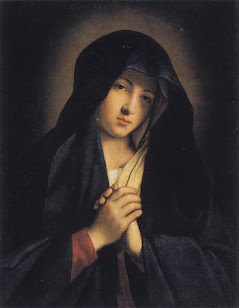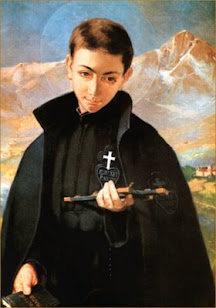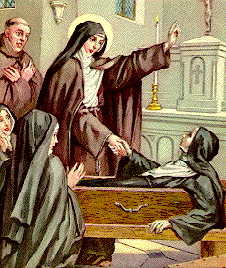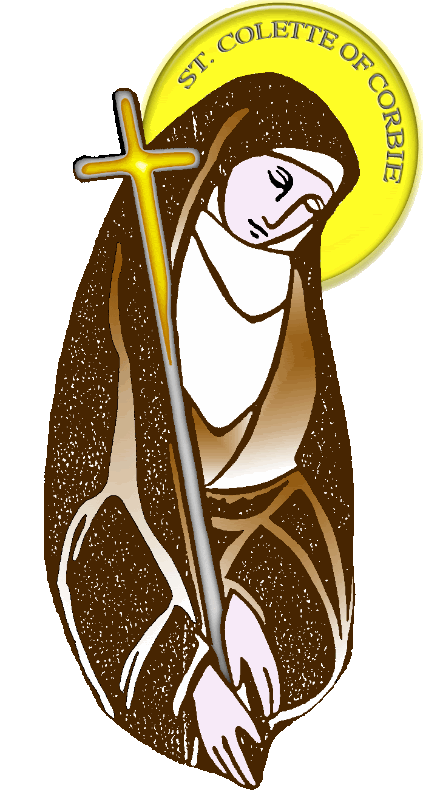On March 6, we celebrate the feast day of Saint Colette (1381-1447), virgin, reformer of the Franciscan Order of Poor Clares, and unifier of the Church. Saint Colette is remembered for her holiness, but also for her initial resistance to the will of God, offered to her in visions. Upon overcoming her fear and reservations, and accepting the Lord’s calling, Saint Colette went on to accomplish great things in the name of God.
Born Nicolette Boellet, but called Colette, her parents were well-advanced in age. Her father, known throughout the region of France, was a well-known carpenter, having constructed monasteries and abbeys in the region. Her mother, over 60 years old, had conceived late in life, following devout prayer to Saint Nicholas, the patron of children.
Colette was orphaned at age 17, and promptly gave her inheritance to the poor of the region. She sought to enter the religious life, but had difficulty finding an order which matched her strict observances. She unsuccessfully entered the Bequines, the Benedictines, and the Urbanist Poor Clares, leaving each due to her perception of their relaxed rules on poverty and obedience. Colette subsequently became a hermitess for three years, living in a small hut adjacent to the church at Corbie, and at age 21, became an anchoress, having herself walled into a cell with only a small window which opened into the church. There she lived for some time in complete solitude, in prayer, fasting, and poverty.
It was while she was secluded that she experienced the great visions which would move her to action. In her first vision, Colette witnessed the moral destruction of the world, a vision which left her frightened and moved. Later, had another vision in which she saw Saint Francis of Assisi come before the Lord, and kneeling down, he begged, “Lord, give me this woman for the reform of my Order” (as the Franciscan Order had been part of Colette's vision of a destroyed world). In the vision, the Lord bowed His head, giving ascent for her mission.
But Colette refused. She was both frightened and unsure of what she had seen. So Lord showed her another vision, this one of a great golden tree from which sprung other trees. Colette understood the vision as she being the first tree, and the nurslings representing the houses she was to found. And yet, in her heart, she continued to refuse. Given that she refused to listen to the Lord, she was struck deaf and dumb for three days, and her inability to see Him, left her blind for another three days. Understanding her physical manifestations as confirmation from God that this was her path, Colette allowed her heart to be changed, and willingly served the Lord.
Gaining permission to leave her cell, Colette walked barefooted, clad in rags, to an audience with the French-recognized Pope Benedict XIII, Pedro de Luna (at that time, there was a great schism in the Church, with three popes claiming authority. Colette would work with Saint Vincent Ferrer to reconcile the Church to itself later in her life). Benedict recognized her sanctity and bestowed upon her the black veil of the Poor Clares, charging her to reformation, and granting her the authority of Mistress over any community which she built or reformed.
Saint Colette set out across France, Belgium, and Spain, reforming and establishing more than 18 Poor Clare communities under the original Rule of Saint Clare. (These communities, for political reasons during the rule of Pope Urban IV, had been forced to adopt less austere ways of life). During her travels, Colette counseled peace between warring countries, miraculously crossing battlefields unharmed. It is said that every person who met her was changed for the better.
Within the communities of the Poor Clares, however, her road was much more difficult. She was treated with unkindness, ostracism, greeted with slander, and accused of sorcery and heresy. Saint Colette received these insults with humility and kindness, eventually meeting with success in her mission. The reformed rule returned the order to extreme poverty, the sisters going barefoot, and observing constant fasting and abstinence. The Poor Clares, some of which are still referred to as Colettines, grew in numbers and devotion under her leadership. They can still be found today in Belgium, England, Spain, Germany, and the United States.
Saint Colette, remembering the vision of the Lord depicting the moral decline of society and the Church, never ceased praying for the sanctity of the Church and it’s leaders. In response, she was continuously plagued by the Devil, who visited upon her torture and temptation. She was frequently surrounded by stinging insects, who swarmed around her, stinging her repeatedly. Decomposing corpses of criminals and heretics would miraculously appear in her cell, even while she was walled in. Saint Colette further would further undergo physical torture and the hands of demons, leaving her bruised, broken, and exhausted. Holy legend tells us that Saint Colette once complained to Our Lord that these demons and trials were keeping her from her prayers. The Devil is said to have responded to her, “Cease, then, your prayers to the great Master of the Church, and we will cease to torment you. For you torment us more by your prayers than we do you.”
And yet, Colette did not complain outwardly. In her own words, she viewed the days in which she suffered no insult for the Lord as the least happy of her life. Saint Colette was renowned for her sanctity and ecstatic visions of the Passion. She would fast every Friday, prayerfully contemplating the Passion, and following reception of the Holy Eucharist would enter ecstatic visions of Christ, lasting hours into the evening. Like Saint Francis, she had an affinity for animals, and demonstrated care for all of God’s creatures. She foretold her own death in her convent at Ghent, Belgium, on March 6, 1447.
Saint Colette serves as a Lenten reminder for us that times of struggle and suffering can lead to redemption and conversion. In her words, "If there be a true way that leads to the Everlasting Kingdom, it is most certainly that of suffering, patiently endured." These words, modeled after the life of Jesus Christ, His suffering for us, call us to patience in this world, and life everlasting in the next.
Day 65 of 365
Prayer Intentions: Patience in our suffering.
Requested Intentions: Safety of travelers (J); Improved family relationship with the Lord, using gifts for His glory (L); For the orphans of Saint Francis Xavier in India (Fr. B); For the health of a family member with Rett’s Disorder (C); For the restoration of hearing (L); For a restorative, faith-deepening Lent for all those who are struggling (L).
Special Intentions (Day 24 of 45-day Novena to Our Blessed Lady of Lourdes): The intentions of all those who read this blog, whether submitted or retained in the quiet of their hearts; Penance, Penance, Penance for sinners; For all those who are suffering.
Why pray the Rosary every day for a year?
Each time the Blessed Virgin has appeared-- whether it be to Saint Bernadette Soubirous at Lourdes; to Lucia, Jacinta, and Francisco at Fatima; or to Mariette Beco at Banneux-- she has asserted the importance, saving grace, and power of praying the Holy Rosary on a daily basis. Based upon her words, the Rosary is penance and conversion for sinners, a pathway to peace, an end to war, and a powerful act of faith in Jesus Christ. Pope Paul VI presented the Rosary as a powerful means to reach Christ "not merely with Mary but indeed, insofar as this is possible to us, in the same way as Mary, who is certainly the one who thought about Him more than anyone else has ever done."
To show us how this is done, perhaps no one has been more eloquent than the great Cardinal Newman, who wrote: "The great power of the Rosary consists in the fact that it translates the Creed into Prayer. Of course, the Creed is already in a certain sense a prayer and a great act of homage towards God, but the Rosary brings us to meditate again on the great truth of His life and death, and brings this truth close to our hearts. Even Christians, although they know God, usually fear rather than love Him. The strength of the Rosary lies in the particular manner in which it considers these mysteries, since all our thinking about Christ is intertwined with the thought of His Mother, in the relations between Mother and Son; the Holy Family is presented to us, the home in which God lived His infinite love."
As Mary said at Fatima, "Jesus wants to use you to make Me known and loved. He wishes to establish the devotion to My Immaculate Heart throughout the world. I promise salvation to whoever embraces it; these souls will be dear to God, like flowers put by Me to adorn his throne."

Subscribe to:
Post Comments (Atom)












0 comments:
Post a Comment
Thanks for leaving a comment. If you wish to submit a prayer request, however, please do so above, using the "Contact" tab.